MBA 601 HRM Case Study: Goal Setting and Employee Motivation Analysis
VerifiedAdded on 2023/04/21
|6
|1137
|409
Case Study
AI Summary
This document presents a case study analysis focusing on Human Resource Management (HRM) practices. The first case examines goal setting and performance appraisal issues at Financial Security Investments, highlighting the importance of fair appraisal processes, motivational techniques, and addressing employee dissatisfaction. The second case delves into a supervisor's handling of a subordinate's declining performance, emphasizing the role of Employee Assistance Programs (EAPs), timely performance assessments, and the significance of motivation in maintaining employee productivity. Both cases underscore the critical role of HRM in fostering a motivated and productive workforce, with implications for overall organizational performance. Desklib provides this and other solved assignments to aid students in their studies.
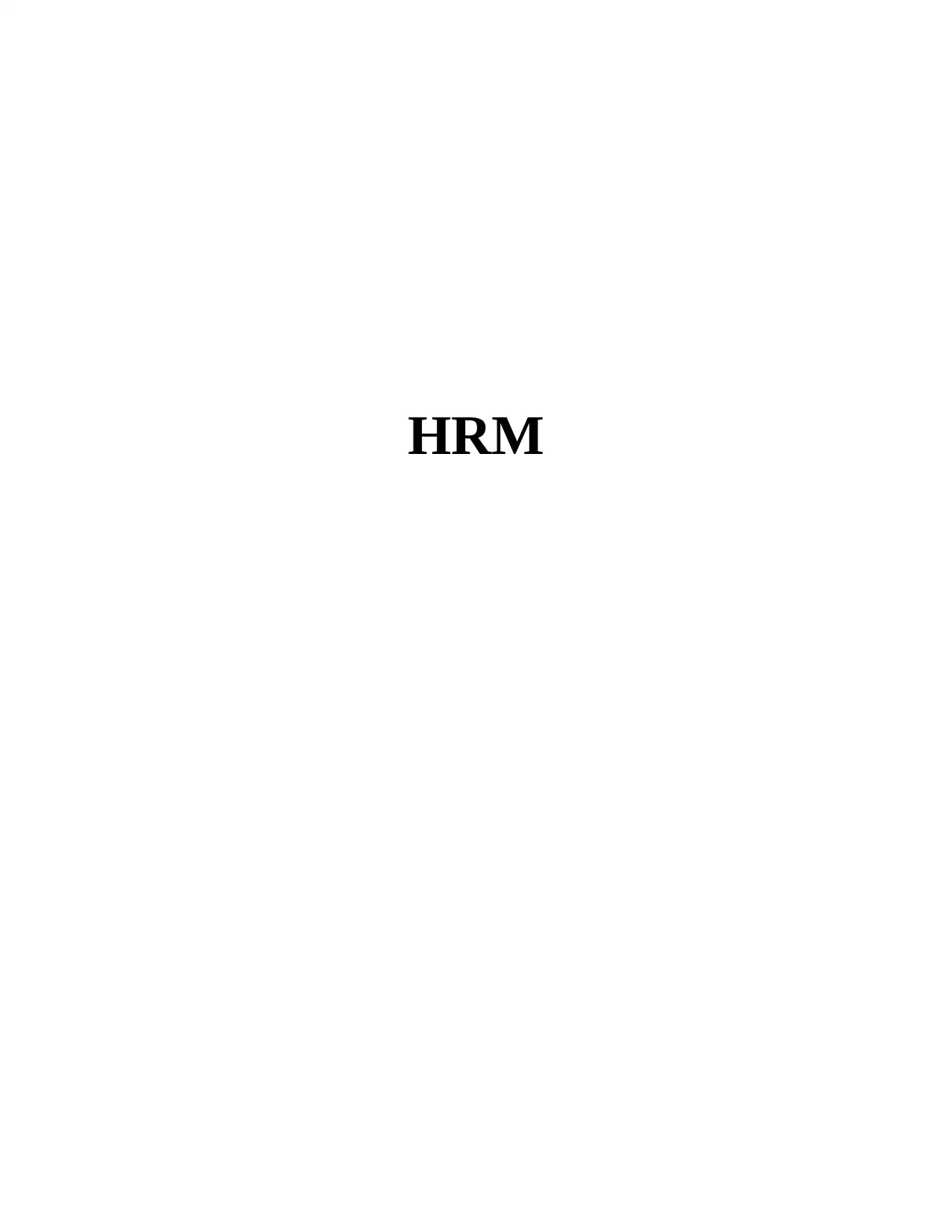
HRM
Paraphrase This Document
Need a fresh take? Get an instant paraphrase of this document with our AI Paraphraser
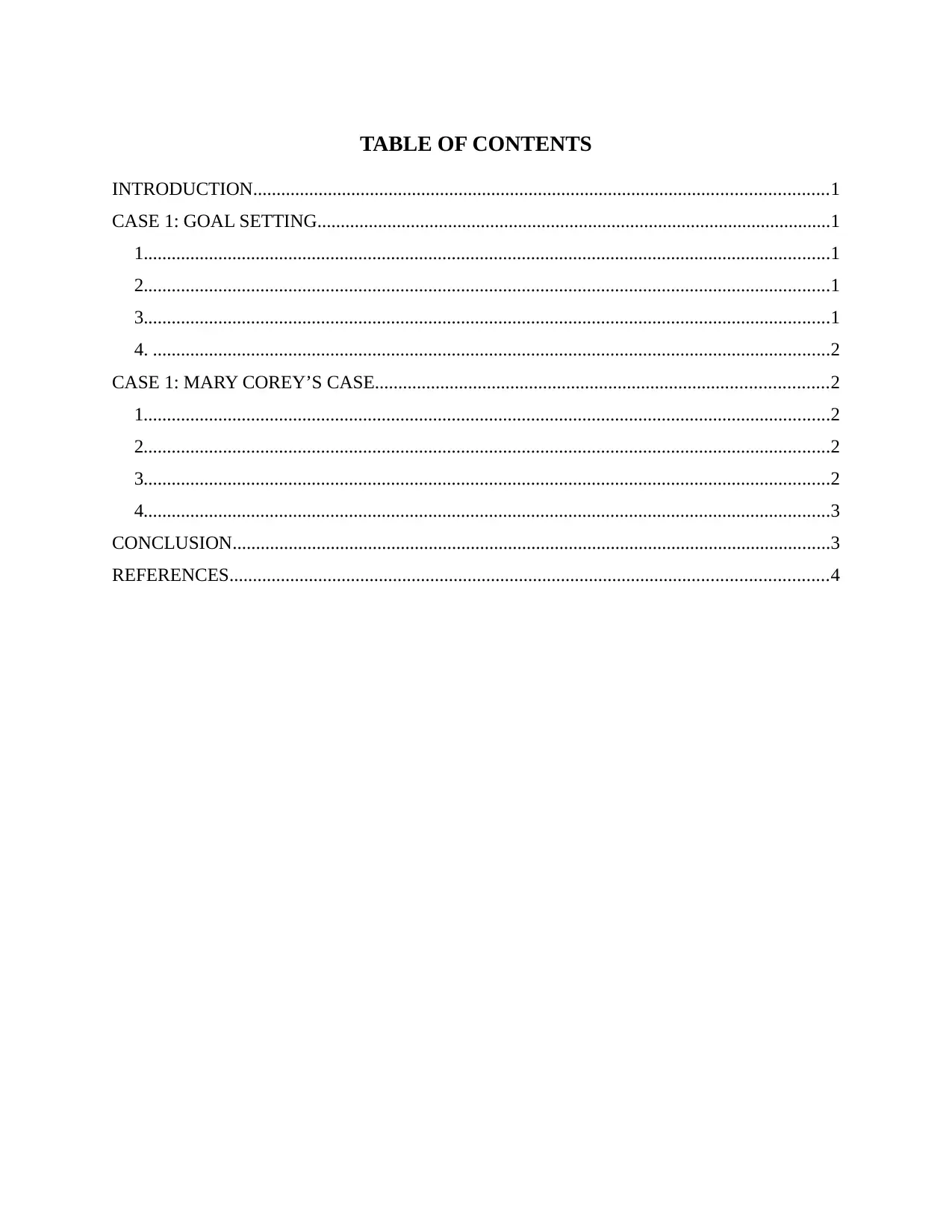
TABLE OF CONTENTS
INTRODUCTION...........................................................................................................................1
CASE 1: GOAL SETTING..............................................................................................................1
1...................................................................................................................................................1
2...................................................................................................................................................1
3...................................................................................................................................................1
4. .................................................................................................................................................2
CASE 1: MARY COREY’S CASE.................................................................................................2
1...................................................................................................................................................2
2...................................................................................................................................................2
3...................................................................................................................................................2
4...................................................................................................................................................3
CONCLUSION................................................................................................................................3
REFERENCES................................................................................................................................4
INTRODUCTION...........................................................................................................................1
CASE 1: GOAL SETTING..............................................................................................................1
1...................................................................................................................................................1
2...................................................................................................................................................1
3...................................................................................................................................................1
4. .................................................................................................................................................2
CASE 1: MARY COREY’S CASE.................................................................................................2
1...................................................................................................................................................2
2...................................................................................................................................................2
3...................................................................................................................................................2
4...................................................................................................................................................3
CONCLUSION................................................................................................................................3
REFERENCES................................................................................................................................4
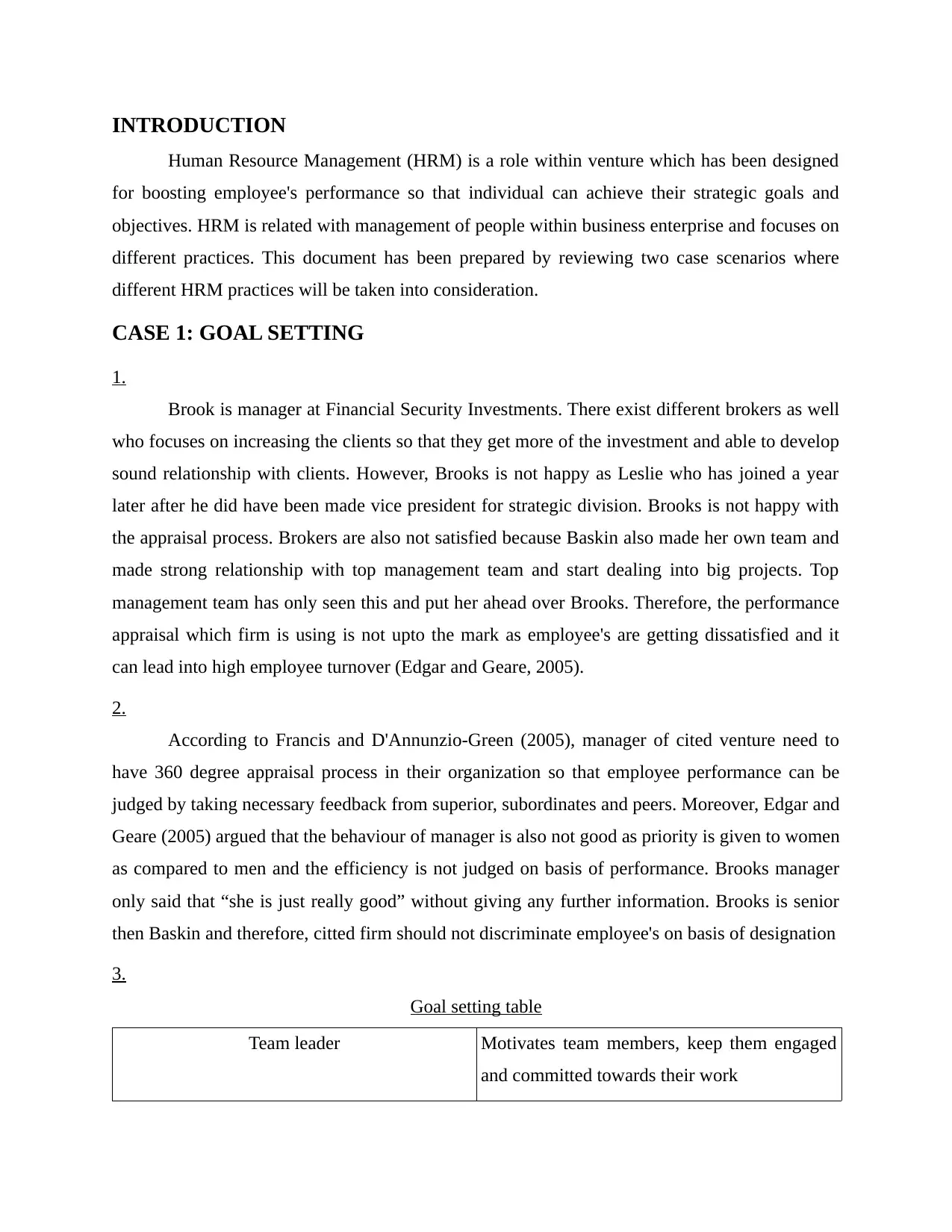
INTRODUCTION
Human Resource Management (HRM) is a role within venture which has been designed
for boosting employee's performance so that individual can achieve their strategic goals and
objectives. HRM is related with management of people within business enterprise and focuses on
different practices. This document has been prepared by reviewing two case scenarios where
different HRM practices will be taken into consideration.
CASE 1: GOAL SETTING
1.
Brook is manager at Financial Security Investments. There exist different brokers as well
who focuses on increasing the clients so that they get more of the investment and able to develop
sound relationship with clients. However, Brooks is not happy as Leslie who has joined a year
later after he did have been made vice president for strategic division. Brooks is not happy with
the appraisal process. Brokers are also not satisfied because Baskin also made her own team and
made strong relationship with top management team and start dealing into big projects. Top
management team has only seen this and put her ahead over Brooks. Therefore, the performance
appraisal which firm is using is not upto the mark as employee's are getting dissatisfied and it
can lead into high employee turnover (Edgar and Geare, 2005).
2.
According to Francis and D'Annunzio‐Green (2005), manager of cited venture need to
have 360 degree appraisal process in their organization so that employee performance can be
judged by taking necessary feedback from superior, subordinates and peers. Moreover, Edgar and
Geare (2005) argued that the behaviour of manager is also not good as priority is given to women
as compared to men and the efficiency is not judged on basis of performance. Brooks manager
only said that “she is just really good” without giving any further information. Brooks is senior
then Baskin and therefore, citted firm should not discriminate employee's on basis of designation
3.
Goal setting table
Team leader Motivates team members, keep them engaged
and committed towards their work
Human Resource Management (HRM) is a role within venture which has been designed
for boosting employee's performance so that individual can achieve their strategic goals and
objectives. HRM is related with management of people within business enterprise and focuses on
different practices. This document has been prepared by reviewing two case scenarios where
different HRM practices will be taken into consideration.
CASE 1: GOAL SETTING
1.
Brook is manager at Financial Security Investments. There exist different brokers as well
who focuses on increasing the clients so that they get more of the investment and able to develop
sound relationship with clients. However, Brooks is not happy as Leslie who has joined a year
later after he did have been made vice president for strategic division. Brooks is not happy with
the appraisal process. Brokers are also not satisfied because Baskin also made her own team and
made strong relationship with top management team and start dealing into big projects. Top
management team has only seen this and put her ahead over Brooks. Therefore, the performance
appraisal which firm is using is not upto the mark as employee's are getting dissatisfied and it
can lead into high employee turnover (Edgar and Geare, 2005).
2.
According to Francis and D'Annunzio‐Green (2005), manager of cited venture need to
have 360 degree appraisal process in their organization so that employee performance can be
judged by taking necessary feedback from superior, subordinates and peers. Moreover, Edgar and
Geare (2005) argued that the behaviour of manager is also not good as priority is given to women
as compared to men and the efficiency is not judged on basis of performance. Brooks manager
only said that “she is just really good” without giving any further information. Brooks is senior
then Baskin and therefore, citted firm should not discriminate employee's on basis of designation
3.
Goal setting table
Team leader Motivates team members, keep them engaged
and committed towards their work
⊘ This is a preview!⊘
Do you want full access?
Subscribe today to unlock all pages.

Trusted by 1+ million students worldwide
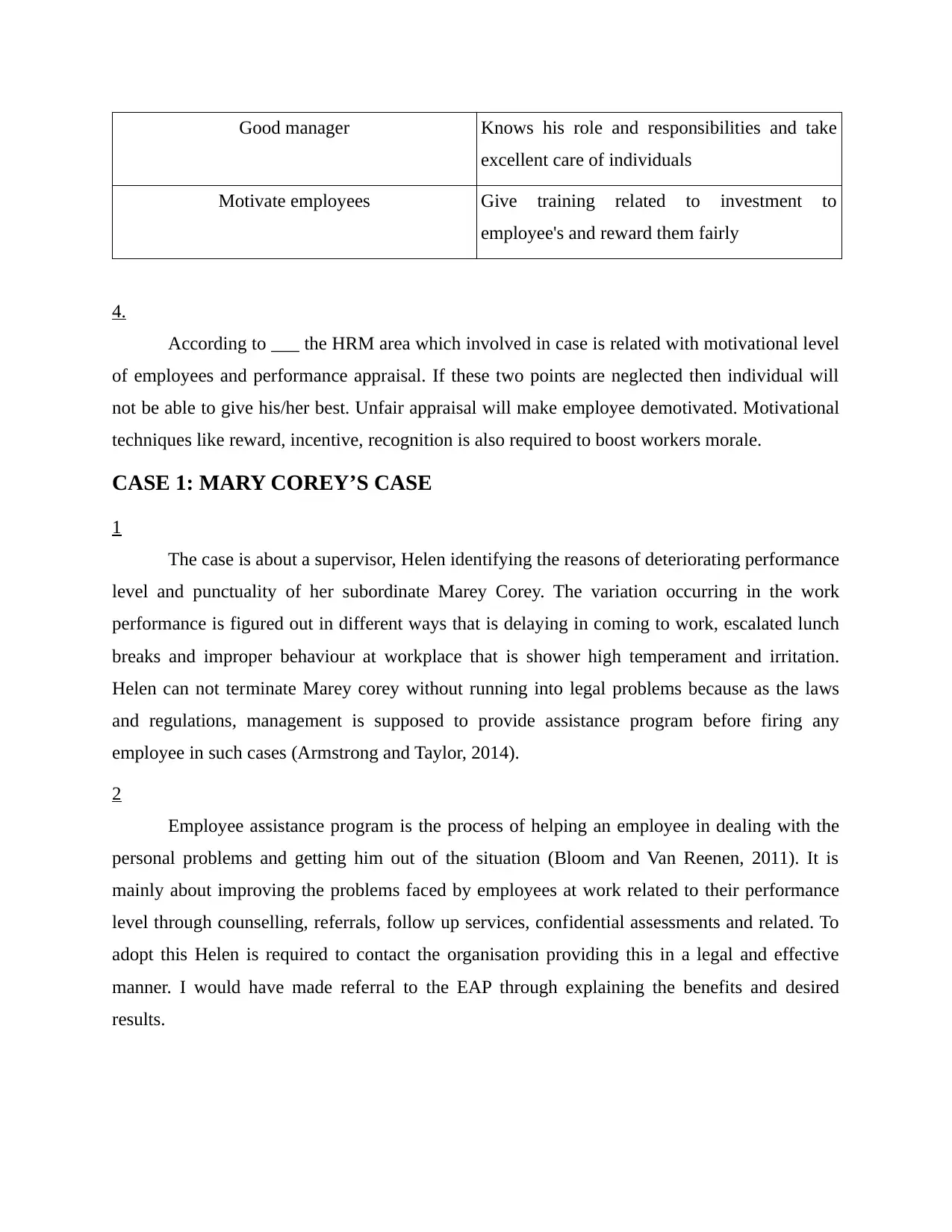
Good manager Knows his role and responsibilities and take
excellent care of individuals
Motivate employees Give training related to investment to
employee's and reward them fairly
4.
According to ___ the HRM area which involved in case is related with motivational level
of employees and performance appraisal. If these two points are neglected then individual will
not be able to give his/her best. Unfair appraisal will make employee demotivated. Motivational
techniques like reward, incentive, recognition is also required to boost workers morale.
CASE 1: MARY COREY’S CASE
1
The case is about a supervisor, Helen identifying the reasons of deteriorating performance
level and punctuality of her subordinate Marey Corey. The variation occurring in the work
performance is figured out in different ways that is delaying in coming to work, escalated lunch
breaks and improper behaviour at workplace that is shower high temperament and irritation.
Helen can not terminate Marey corey without running into legal problems because as the laws
and regulations, management is supposed to provide assistance program before firing any
employee in such cases (Armstrong and Taylor, 2014).
2
Employee assistance program is the process of helping an employee in dealing with the
personal problems and getting him out of the situation (Bloom and Van Reenen, 2011). It is
mainly about improving the problems faced by employees at work related to their performance
level through counselling, referrals, follow up services, confidential assessments and related. To
adopt this Helen is required to contact the organisation providing this in a legal and effective
manner. I would have made referral to the EAP through explaining the benefits and desired
results.
excellent care of individuals
Motivate employees Give training related to investment to
employee's and reward them fairly
4.
According to ___ the HRM area which involved in case is related with motivational level
of employees and performance appraisal. If these two points are neglected then individual will
not be able to give his/her best. Unfair appraisal will make employee demotivated. Motivational
techniques like reward, incentive, recognition is also required to boost workers morale.
CASE 1: MARY COREY’S CASE
1
The case is about a supervisor, Helen identifying the reasons of deteriorating performance
level and punctuality of her subordinate Marey Corey. The variation occurring in the work
performance is figured out in different ways that is delaying in coming to work, escalated lunch
breaks and improper behaviour at workplace that is shower high temperament and irritation.
Helen can not terminate Marey corey without running into legal problems because as the laws
and regulations, management is supposed to provide assistance program before firing any
employee in such cases (Armstrong and Taylor, 2014).
2
Employee assistance program is the process of helping an employee in dealing with the
personal problems and getting him out of the situation (Bloom and Van Reenen, 2011). It is
mainly about improving the problems faced by employees at work related to their performance
level through counselling, referrals, follow up services, confidential assessments and related. To
adopt this Helen is required to contact the organisation providing this in a legal and effective
manner. I would have made referral to the EAP through explaining the benefits and desired
results.
Paraphrase This Document
Need a fresh take? Get an instant paraphrase of this document with our AI Paraphraser
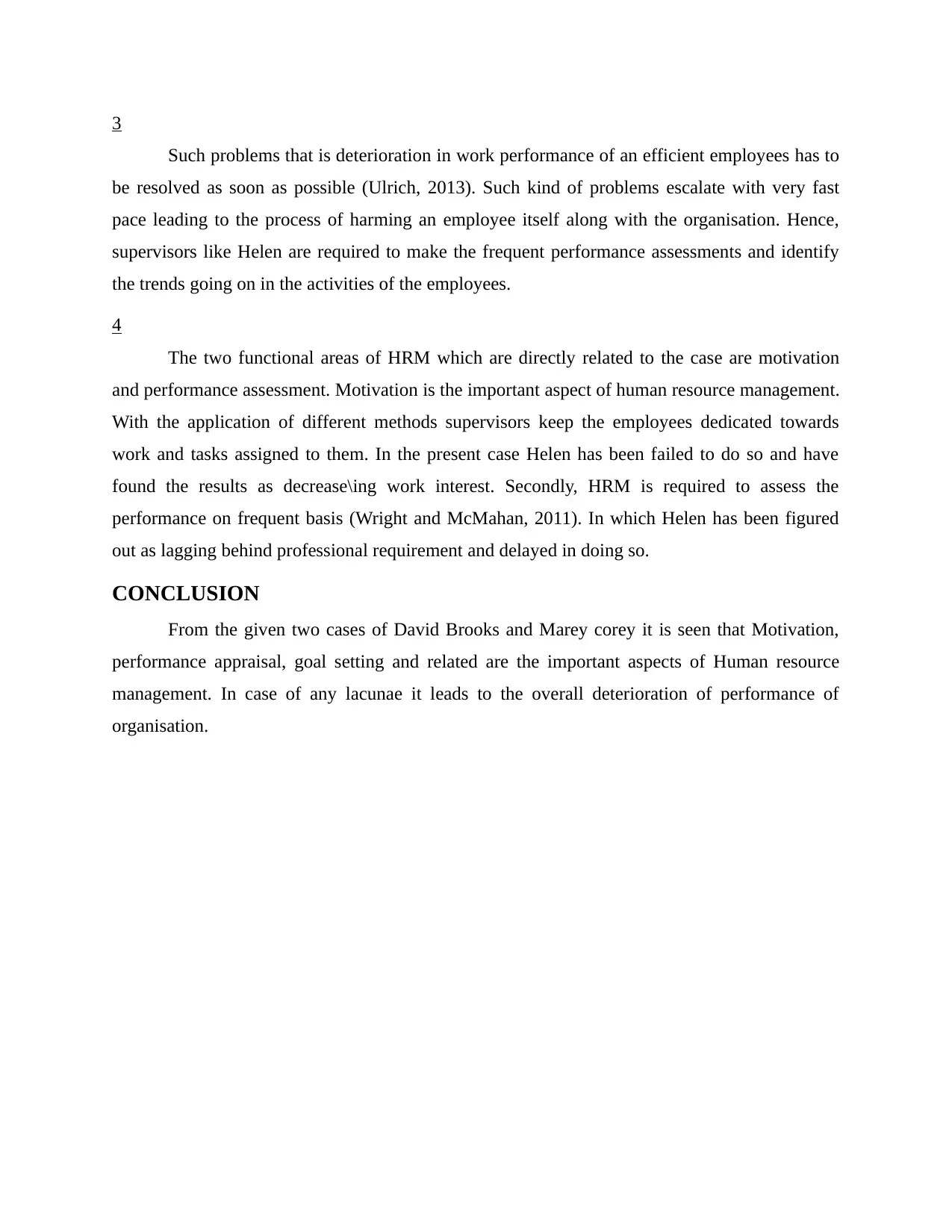
3
Such problems that is deterioration in work performance of an efficient employees has to
be resolved as soon as possible (Ulrich, 2013). Such kind of problems escalate with very fast
pace leading to the process of harming an employee itself along with the organisation. Hence,
supervisors like Helen are required to make the frequent performance assessments and identify
the trends going on in the activities of the employees.
4
The two functional areas of HRM which are directly related to the case are motivation
and performance assessment. Motivation is the important aspect of human resource management.
With the application of different methods supervisors keep the employees dedicated towards
work and tasks assigned to them. In the present case Helen has been failed to do so and have
found the results as decrease\ing work interest. Secondly, HRM is required to assess the
performance on frequent basis (Wright and McMahan, 2011). In which Helen has been figured
out as lagging behind professional requirement and delayed in doing so.
CONCLUSION
From the given two cases of David Brooks and Marey corey it is seen that Motivation,
performance appraisal, goal setting and related are the important aspects of Human resource
management. In case of any lacunae it leads to the overall deterioration of performance of
organisation.
Such problems that is deterioration in work performance of an efficient employees has to
be resolved as soon as possible (Ulrich, 2013). Such kind of problems escalate with very fast
pace leading to the process of harming an employee itself along with the organisation. Hence,
supervisors like Helen are required to make the frequent performance assessments and identify
the trends going on in the activities of the employees.
4
The two functional areas of HRM which are directly related to the case are motivation
and performance assessment. Motivation is the important aspect of human resource management.
With the application of different methods supervisors keep the employees dedicated towards
work and tasks assigned to them. In the present case Helen has been failed to do so and have
found the results as decrease\ing work interest. Secondly, HRM is required to assess the
performance on frequent basis (Wright and McMahan, 2011). In which Helen has been figured
out as lagging behind professional requirement and delayed in doing so.
CONCLUSION
From the given two cases of David Brooks and Marey corey it is seen that Motivation,
performance appraisal, goal setting and related are the important aspects of Human resource
management. In case of any lacunae it leads to the overall deterioration of performance of
organisation.
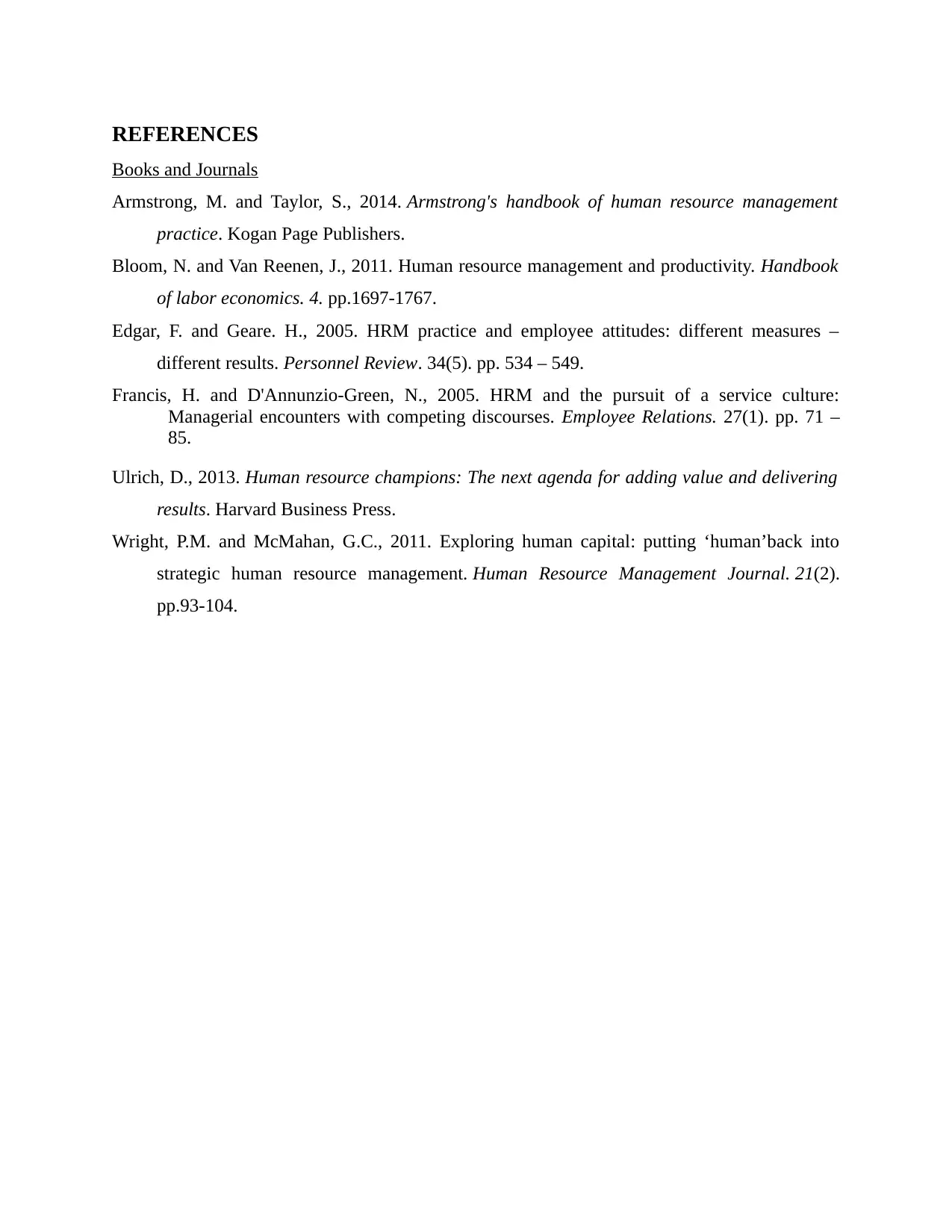
REFERENCES
Books and Journals
Armstrong, M. and Taylor, S., 2014. Armstrong's handbook of human resource management
practice. Kogan Page Publishers.
Bloom, N. and Van Reenen, J., 2011. Human resource management and productivity. Handbook
of labor economics. 4. pp.1697-1767.
Edgar, F. and Geare. H., 2005. HRM practice and employee attitudes: different measures –
different results. Personnel Review. 34(5). pp. 534 – 549.
Francis, H. and D'Annunzio‐Green, N., 2005. HRM and the pursuit of a service culture:
Managerial encounters with competing discourses. Employee Relations. 27(1). pp. 71 –
85.
Ulrich, D., 2013. Human resource champions: The next agenda for adding value and delivering
results. Harvard Business Press.
Wright, P.M. and McMahan, G.C., 2011. Exploring human capital: putting ‘human’back into
strategic human resource management. Human Resource Management Journal. 21(2).
pp.93-104.
Books and Journals
Armstrong, M. and Taylor, S., 2014. Armstrong's handbook of human resource management
practice. Kogan Page Publishers.
Bloom, N. and Van Reenen, J., 2011. Human resource management and productivity. Handbook
of labor economics. 4. pp.1697-1767.
Edgar, F. and Geare. H., 2005. HRM practice and employee attitudes: different measures –
different results. Personnel Review. 34(5). pp. 534 – 549.
Francis, H. and D'Annunzio‐Green, N., 2005. HRM and the pursuit of a service culture:
Managerial encounters with competing discourses. Employee Relations. 27(1). pp. 71 –
85.
Ulrich, D., 2013. Human resource champions: The next agenda for adding value and delivering
results. Harvard Business Press.
Wright, P.M. and McMahan, G.C., 2011. Exploring human capital: putting ‘human’back into
strategic human resource management. Human Resource Management Journal. 21(2).
pp.93-104.
⊘ This is a preview!⊘
Do you want full access?
Subscribe today to unlock all pages.

Trusted by 1+ million students worldwide
1 out of 6
Related Documents
Your All-in-One AI-Powered Toolkit for Academic Success.
+13062052269
info@desklib.com
Available 24*7 on WhatsApp / Email
![[object Object]](/_next/static/media/star-bottom.7253800d.svg)
Unlock your academic potential
Copyright © 2020–2025 A2Z Services. All Rights Reserved. Developed and managed by ZUCOL.





